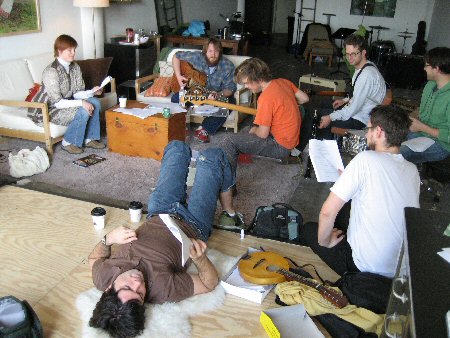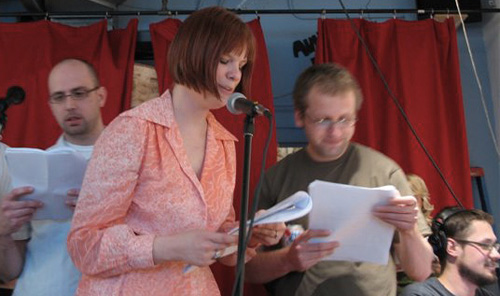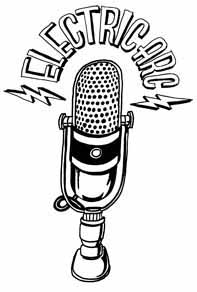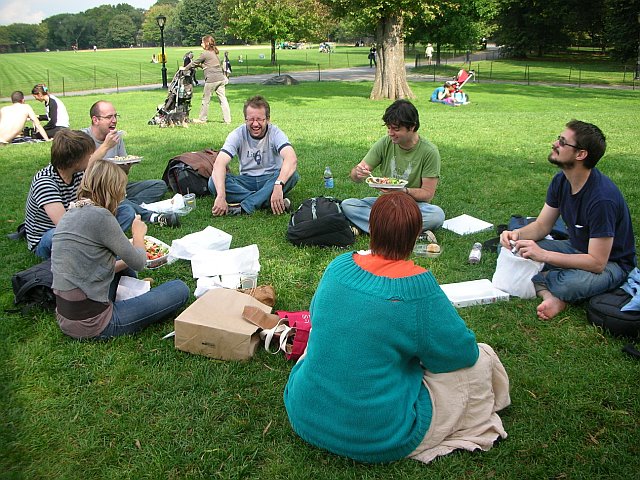Coming to a Radio Near You: Electric Arc Radio and the Lit 6 Project
a+E chats with the writers, actors, and musicians behind Electric Arc Radio about the persuasive powers of malt liquor and their bold reinvention of the traditional author readings. Tune in: It'll be broadcast on MPR's The Current throughout January 2008.





Let’s Put On a Show!
Originally published in December 2006.
THE LAST TIME YOU WERE PART OF ANYTHING AS GUILELESSLY EXUBERANT as an Electric Arc Radio show you were nine years old, with your cousins and siblings, putting on a performance from behind the couch for your relatives. Except, unlike you and your kidly cohorts, the writers of the Lit 6 Project and the actors and musicians from Creative Electric Studios actually put on a savvy, funny, literate show.
The conceit of the Electric Arc storyline is simple: four obsessive, misfit writers all live together in a two-story house in south Minneapolis. It’s not that weird until you consider that Alan Greenspan (“G-Span”), the former Chairman of the Federal Reserve, also resides in their backyard treehouse and has taken up the clarinet; Björk is a personal guardian angel for the group; their life-narrator lives in the attic and provides a soundtrack to their lives; and their day-to-day business frequently overlaps with the doings of Robert “Hart to Hart” Wagner, Gorbachev, and other surprising celebrities.
Oh yeah… and there are musical numbers. It’s easy to compare Electric Arc Radio to Prairie Home Companion, and people have; but, the Lit 6 stories are structured more like Escher-esque After School Specials than Garrison Keillor’s homespun yarns. And at first glance, it’s especially tempting to compare Electric Arc’s pop culture laden humor with that of young writers behind the self-consciously hip satire of McSweeney’s ilk. But that’s facile too. Electric Arc offers entertaining writing that’s smart but big-hearted; the show’s writing is pop savvy, but the vibe of the show is inviting and never hipper-than-thou.
I caught the Electric Arc Radio crew at Creative Electric Studios, just after their last show of the 2006 season in mid-December. Turnout was great that night—over 200 people came to see them perform—and the cast was still juiced about that. It was, perhaps, their most successful draw yet and their very special holiday episode had been a huge hit with the crowd.
When we all settle in with some drinks, Sam Osterhout opens with the story of the group’s origins. “I was in the MFA program for writing at Hamline, and I really wanted to write like Steinbeck. I worked really hard at it, but it just wasn’t happening. I discovered that what I’m actually good at is writing fart jokes, and it’s hard to make that work for an MFA program.”
Sam continues, “I was going to readings pretty often, because that was my field after all, and I noticed that the audience was the same from reading to reading. It was the same crowd, no matter the author, and all of us were exceedingly bored. So I started this thing, Live Lit, to be a different kind of reading. I hoped people would come because they wanted to be there and were having a good time. The only thing I could think to do, at first, was to provide malt liquor to the audience. At one of the Live Lit shows, [Geoff] Herbach read, and he just exploded in front of the audience.”
Herbach pipes up, “So to speak.”
Sam continues without missing a beat, “The Live Lit idea was at a crossroads, my partner had moved on to other things. So, I called Herbach after the reading, and together we re-envisioned the whole thing. We decided that performance was the key: we needed to get authors to read who understood how to entertain an audience, not just on stage, but with their writing. In our vision of the perfect reading the writing would be bold and edgy and funny, and the performance would be the same. We would provide alcohol to the audience, and the whole thing would be a party. That’s how Live Lit became the Lit 6 Project.”
He goes on, “Herbach and I pulled in all these wonderful writers, and in the process it became clear that Steph (Ash) and Brady (Bergeson) were just the utmost, the best of the best. We asked them to officially join us. Shortly after we four came together as Lit 6, we performed here [at Creative Electric Studios] for the first time.”
Stephanie adds, “And that’s when we first performed writings created as connected narratives. We decided to give ourselves a situation to work from: we were all writers who lived together and someone stole a housemate’s Diet Pepsi from the fridge. Things really snowballed from there. Writing these connected stories, together as a group, for performance just changed everything.”
The writers of Lit 6 met up with the musicians and artists of Creative Electric Studios—Kurt Froehlich, David Salmela, Quillan Roe, Mike Brady, and Jenny Adams—through a mutual artist friend. “What really got us all involved together was that Dave [Salmela], Jenny and Kurt [Froehlich] from Creative Electric were the first to give us, real, honest feedback. They had concrete suggestions and criticisms—they were straight with us about what worked and what didn’t—and it felt really natural to work together,” Sam explains.
Stephanie says, “At some point, we started to think of it as a radio show, with narration and continuing characters, and even music. But then we needed more voices and players, and these guys [motioning to the Creative Electric Studios folks] were in and out while we worked, so Dave and Kurt and Jenny started reading, too. Then, Quillan and Mike got into it. We were stunned to find out how great everyone was at playing characters. They were so good that we started writing material for them. Kurt makes a great Mikhail Baryshnikov and Gorbachev [laughing]. He’s so good.” Jenny interjects, “Or what about when he played Robert Wagner’s gay lover from Tahoe?”
As if on cue, everyone screams “Oh my God, the gay lover from Tahoe! That was fantastic! And at this point, Kurt is Greenspan. We don’t even really know quite what Alan Greenspan sounds like, but I’m sure he sounds like Kurt.”
Through all this exclamation, Kurt seems a little embarrassed. But it’s true—I’m not sure quite what Greenspan sounds like either, but after seeing the show, I’m almost positive he sounds like Kurt. I can also attest to the fact that Jenny’s Björk brings down the house.
“It’s better than if we had professional actors, I think,” Salmela opines. “They’re awesome at this.”
I ask about the strangeness of getting a bunch of authors, an occupation that typically draws a performance-shy type of person, to do this sort of outrageous show. Brady muses, “Being a solitary writer isn’t easy. It’s lonely. I’d been a reporter before, and working alone all the time really gets to you. The collaborative process and the energy that’s produced from it is what hooked me about being part of this. So, sure—I’m still working alone much of the time, writing by myself—but there’s going to be this other thing I do, with all these guys, that’ll be a welcome relief from that.”
Herbach echoes that sentiment, “I can’t tell you what it’s like to have access to the talent these guys have. I mean, I’ve always written stupid song lyrics. They just bounce around in my head. But now, I can hand them over to Dave and in no time, he’ll come out with this amazing pop song. I can put my rock-star dreams in Dave’s hands, and he’ll accomplish what I could never do on my own. I love it.”
Stephanie: “This really is a rock-and-roll dream for a writer. This is what it must be like to hear a song you wrote end up on the radio. I don’t play an instrument, and I can’t sing for shit, but I know some people who can. I’m gonna write this thing, and then stand up and deliver it, and I’ll have all these talented people doing it with me. For a lonely, solitary writer, it’s the most gratifying experience to hear a beautiful song come out of what you’ve written, to hear your words narrated so artfully—it’s almost like sharing a dream with nine other people, some of whom are these amazing musicians and actors, and then 200 people come to see what you’ve done. What’s better than that?”
Dave says, “We just want to create something new. Not the same old rock show or author readings. It’s all about generating the material. It’s liberating to do it without having the time to dwell on it too much—I mean, if I’m writing a song for the show, I have to do it by tomorrow. I have no choice but to just write it. If I were just a musician alone in my room writing something for a record, I might have months to work on it. But this is almost better.”
Stephanie observes, “I think it’s central to how exciting this is that it all happens quickly, that the seams are visible to the audience.”
“When Herbach and I met and were talking about this, way back, sitting at the Chatterbox,” Sam interjects, “this is exactly what we talked about. We envisioned that the perfect kind of reading would be like an inside joke, something that would draw in the audience. We, as performers and writers, instead of standing at the podium, separate from the crowd, needed to be there for them, not the other way around. We give them things—we had a meat raffle, we give them booze.” Stephanie chimes in to add, “You wrote stories on the spot for them.” Jenny says, “Smitten Kitten, one of our sponsors, gave vibrators and gift bags of sex toys to our audience.”
And maybe that really is the key to what makes an Electric Arc Show so appealing—seams, shaggy edges, laugh-out-loud bawdiness, and all. The audience gets to see the inside of the show, how the process works, and, maybe most importantly, the Electric Arc crew aren’t too cool to let us see just how much fun they’re having too. Geoff Herbach enthuses, “We’ve talked about this over and over. I think people like us because they can interact with us, we’re nothing too special. We’re just people who write something they like. Then we get on stage and have a great time. And we’re just so grateful that you’re there with us.”